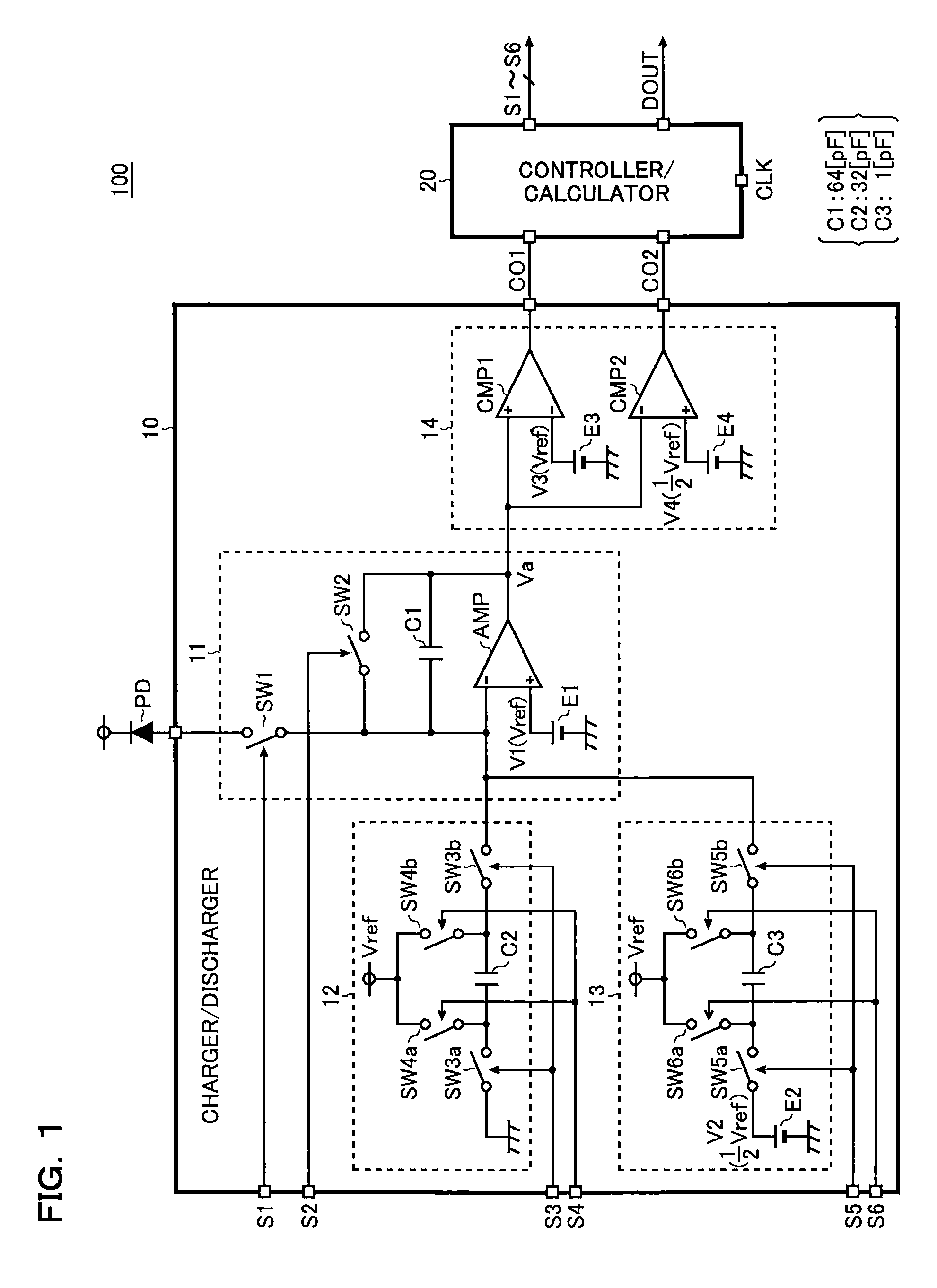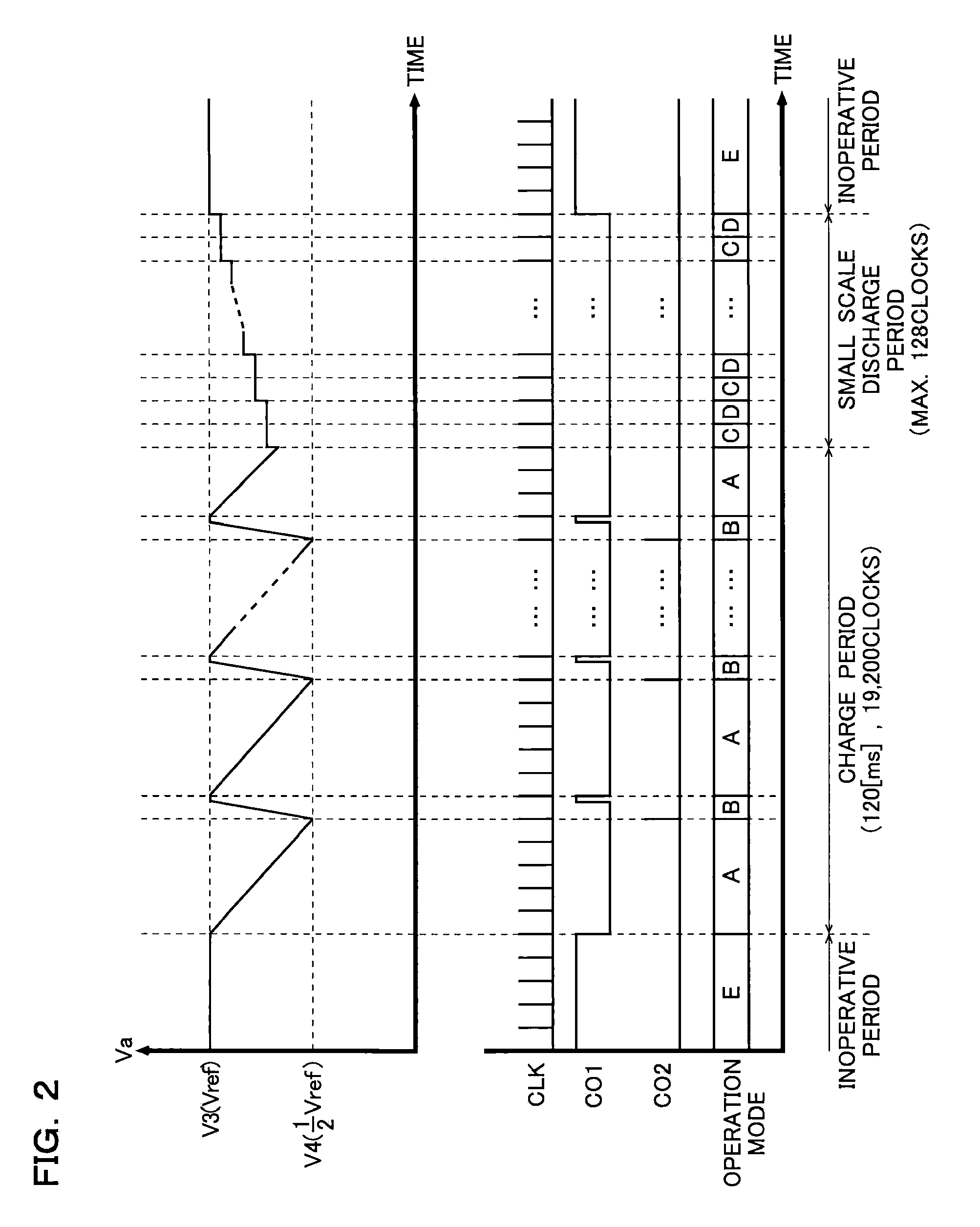Analog/digital converter, illuminance sensor, illumination device, and electronic device
an analog/digital converter and illuminance sensor technology, applied in analogue/digital conversion, transmission systems, instruments, etc., can solve the problems of increasing circuit scale, narrow input dynamic range, and long conversion time required, and achieve enhanced minimum resolution, short measurement time, and wide input dynamic range
- Summary
- Abstract
- Description
- Claims
- Application Information
AI Technical Summary
Benefits of technology
Problems solved by technology
Method used
Image
Examples
first embodiment
[0029]FIG. 1 is a circuit diagram showing an illuminance sensor according to the invention, as a
[0030]As shown in FIG. 1, the illuminance sensor 100 of this embodiment includes: a photodiode PD that converts measurement-target light into an electric current; and an analog / digital converter (a charger / discharger 10 and a controller / calculator 20) that receives, as an input current to it, the output of the photodiode PD. Thus, the illuminance sensor 100 yields a digital output according to illuminance.
[0031]The charger / discharger 10 includes a charge circuit (integrating operational amplifier) 11, a first discharge circuit 12, a second discharge circuit 13, and a comparison circuit 14.
[0032]The charge circuit 11 stores an electric charge according to an input current (the detection current from the photodiode PD) for a predetermined charge period. The charge circuit 11 includes: an operational amplifier AMP; a charge capacitor C1 (in this embodiment, with a capacitance of 64 pF) of wh...
second embodiment
[0060]FIG. 4 is a circuit diagram showing an illumination sensor according to the invention, as a
[0061]For example, as shown in FIG. 4, a second discharge circuit 13′ including a constant current circuit I1 and a switch SW5 may be used. In this configuration, after the end of the charge period of the capacitor C1, the switch SW5 is closed so that the electric charge in the capacitor C1 is discharged by the constant current circuit I1 at a predetermined rate; meanwhile, the time that passes until the electric charge in the capacitor C1 decreases to a predetermined level is measured as by counting pulses in the clock signal CLK.
[0062]With this configuration, after coarse measurements are made based on the number of large-scale discharges by the first discharge circuit 12, it is simply necessary to measure, for the small amount of electric charge remaining in the capacitor C1, the discharge duration of the second discharge circuit 13. Thus, even in a case where the input current from t...
third embodiment
[0063]Next, as a third embodiment, another illuminance sensor according to the present invention will be described in detail with reference to FIG. 5.
[0064]FIG. 5 is a circuit diagram showing an illumination sensor according to the invention, as a third embodiment.
[0065]The illuminance sensor 100 of this embodiment has almost the same configuration as those of the first and second embodiments described previously. The unique feature here is that the use of photodiodes PD1 and PD2 having different photodetective characteristics allows measurement of the targeted wavelength alone. In the following description, accordingly, such parts as find their counterparts in the first and second embodiments are identified with reference numerals and symbols common to FIGS. 1 and 4, and no detailed explanation of such parts will be repeated; thus, the following description proceeds with emphasis placed on the features unique to this embodiment.
[0066]As shown in FIG. 5, the illuminance sensor 100 o...
PUM
 Login to View More
Login to View More Abstract
Description
Claims
Application Information
 Login to View More
Login to View More - R&D
- Intellectual Property
- Life Sciences
- Materials
- Tech Scout
- Unparalleled Data Quality
- Higher Quality Content
- 60% Fewer Hallucinations
Browse by: Latest US Patents, China's latest patents, Technical Efficacy Thesaurus, Application Domain, Technology Topic, Popular Technical Reports.
© 2025 PatSnap. All rights reserved.Legal|Privacy policy|Modern Slavery Act Transparency Statement|Sitemap|About US| Contact US: help@patsnap.com



